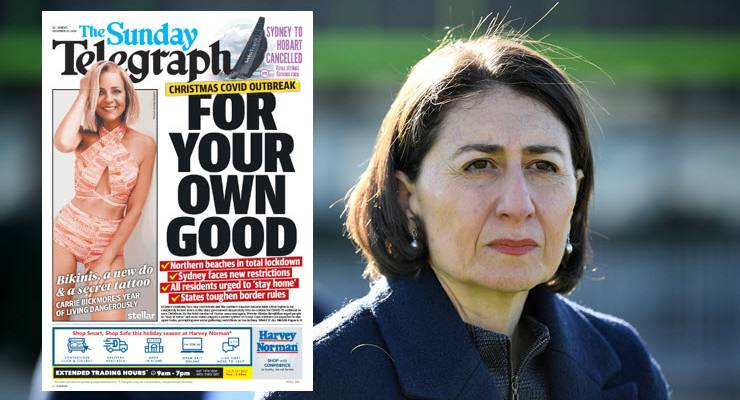
News Corp has stopped pretending. It’s now out and proud as political party media. But there’s still one big question: who’s in charge? The party or the media?
It’s a tale of two cities. This past weekend, the front page of The Sunday Telegraph read “FOR YOUR OWN GOOD” on the Sydney lockdown. Contrast that with the Herald Sun’s front page on Melbourne’s July lockdown: “SIX-WEEK SENTENCE” (complete with its “Disaster for Dan” subhead).
There’s also virtual media silence over the isolation rule-breakers on Sydney’s wealthy northern beaches. It seems they’re not deserving of a Courier-Mail-style “ENEMIES OF THE STATE” mugshot.
Maybe News Corp has got better at understanding how governments manage risk in a pandemic. Governments can learn the lessons of the past. Why not news media?
Maybe not all outbreaks are equal. After all, it’s always going to be easier to lock down Sydney’s wealthy, Liberal-voting northern beaches than Melbourne’s western suburbs. (They don’t call it “the insular peninsula” for nothing!)
The NSW government, however, won’t be too confident. Gladys Berejiklian has never been News Corp’s Liberal premier of choice. She’s already considered to be on borrowed time until the more acceptably male Treasurer Dom Perrottet can put a bit of distance between himself and the icare scandal.
The apparent News Corp tabloid shift from July to December is, journalistically, shocking — but it shouldn’t be surprising.
The company has decided to open up about its positioning. It once used to dog-whistle, famously with the Fox “fair and balanced” tagline. It relied on the “good journalists” to offset its campaigning op-eds and banner headlines.
But when ex-PM Malcolm Turnbull called this out on Q+A — News Corp’s climate coverage, he said, had turned an “issue of physics into an issue of values or identity” — one of these good journalists, Paul Kelly, shrugged.
In a long interview with former deputy PM John Anderson, released that same week in November, Kelly was brutally honest in explaining the News Corp business model: the shift from advertising to subscriptions sorts the media politically, based on audience demand, with News Corp on the right (I made a similar argument here in Crikey this month).
But News Corp has more than glommed on to a loyal political audience; it is now the voice of the Liberal Party. It’s a reverse takeover. The Liberal Party is now little more than the political wing of News Corp.
The 2018 book Network Propaganda goes into this issue in depth. It’s not just that audiences want different perspectives, they want different things.
Audiences on the centre and left want news that gives analysis and context. They’re open to critiques of their own side. And audiences on the right want confirmation bias. They want to see their cultural and political enemies publicly eviscerated — whether it’s a Labor premier or young women of colour breaking quarantine.
News Corp’s deep roots in traditional journalism means it has long tried to bridge the divide, delivering both news analysis (albeit from a conservative perspective) and red meat for its audience.
It meshes these two lumps of content together to create talking points which it can amplify through the voices of backbench ultras (Hello, Craig Kelly!) as diktats for government action.
The Sky schtick (news-ish by day, ranty by night) replicates the Fox model. It’s integrated into the Fox social media environment, with its Sky After Dark YouTube clips going viral in Trump world as transnational validation.
But, as Trump is again teaching Fox, there’s only so much “fact” its audience is prepared to tolerate in this mix. Fox journalists now find themselves hammered by Trump’s supporters for questioning his false stolen election narrative, while its late-night commentariat eggs them on.
Right-wing voices like Newsmax and the One America News Network stick loyal to the Trumpian Lost Cause. They’re rewarded with Trump retweets and a growing audience. They’re dwarfed by Fox on the right, but they’re dragging enough viewers to cost Fox its coveted top spot in the cable news world to (gasp!) CNN.
The Australian market has been too small for a voice to the right of News Corp. But take News Corp at its word: it’s not taking any risks with its base, and it’s unlikely to let its political wing in Canberra do so either.








I think the rest of the media just needs to start freezing out NewsCorp. Stop having their jounros on Q&A or Insiders and leave their biased views in their own bubble. If journos like Savva kick up a stink, they can actual have some moral scruples and leave Newscorp.
I believe some journalists with principles have already let News Corp, but it must be tough when you need the job and the money, and journalism jobs are pretty thin on the ground these days.
If they had principles they would not have joined that appalling company in the first instance.
There is something profoundly antisocial and narcissistic about the way Rupert – and the Muppets along with him for the ride – conducts his business, using his position and influence the way he does …. to the market to which it panders.
The 4th Estate can make one hell of a 5th Column..The scribes & stenographers are in need a real civil war amongst themselves, if they want to manufacture any social democratic validity of substance.
There are now many who’ve been discharged from Lord Moloch’s service so they’d have good reason to form an irregular contingent of insurgents.
Perhaps old habits die hard or they are still too embarrassed to show their faces in public.
Apart from those (far too many) who have landed here.
When the Sirens call, they cannot resist.
Of course News Corp is anti-social: it was founded as “the bosses paper”, to counteract the popularity of the then-dominant union-supported newspaper in SA.
DONT buy or support Murdoch’s NewsCrap products.
If you want read Mudracker then go to Macca’s, always free and saves you wasting money on his crap
Does Gladys hold daily CONFERENCES as Dan Andrews did, is no credibility Credln at the forefront of hounding Gladys ?
I think not on all counts, Gladys should send ICAC to the media briefings,as they seem to have a better understanding on N.S.W.
According to Gladys, her attending pressers are filtered beforehand through the management of her personal Media Director.
Wha…? “…one of these good journalists, Paul Kelly…”? shome mishtake shorely?
The Polonius of the Press Gallery?
The lurker behind the arras, hearing everything, dispensing advice which is comprehensively wrong in every particular?
Oh for a good blade – “How now, a rat? Dead for a ducat, dead!” – there’s many would do the deed for free.